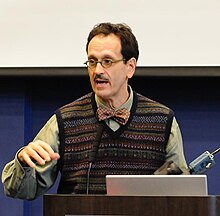Gregory Heisler
Gregory Heisler (* 1954) is an American photographer who is best known for his expressive portraits. In the course of his career, Heisler photographed more than 70 cover covers for the American news magazine Time . In addition, his works have appeared in magazines such as Life , Esquire , GQ , Sports Illustrated , ESPN The Magazine , Fortune and the New York Times Magazine .
life and work
In an interview for the Canon Explorers Of Light series , Heisler describes how enthusiastic he was about science and especially about astronomy as a child . According to Heisler, he bought a camera as an accessory for his telescope in order to take pictures of the night sky. But when he discovered his enthusiasm for photography , he sold the telescope in order to be able to afford a second lens for his camera instead .
At the age of twenty-one, Heisler moved from Chicago to New York in 1975 , where he worked for the next nine months in the studio of the famous portrait photographer Arnold Newman . In a review in 2014, Heisler reported how much Newman influenced him. He particularly emphasized Newman's ability to compose painstakingly, which often also included the people's surroundings in the picture (English environmental portraiture ).
|
Time title cover selection of external web links |
Heisler gained particular fame through his series of cover covers for the news magazine Time . Among others, he shot Bill Clinton , Bruce Springsteen , Jassir Arafat , Michael Phelps , Christopher Reeve and David Lynch for Time . Some of these images appeared in the book 50 Portraits published in 2013 , in which Heisler describes in detail the creation concept, the technology he used and the behavior of the people portrayed for each of the images.
In 1990, Heisler briefly lost his accreditation in the White House after he photographed the then incumbent President George HW Bush using a double exposure as if he had two faces. In his memories of the incident, the former Bush spokesman described that Heisler had meticulously prepared his recordings by marking the camera positions on the floor and photographing Bush's face from very specific angles. One of the portraits taken that day was later used as the first cover cover in Time magazine's "Person of the Year" series. After Heisler protested against the loss of his accreditation, it was only put back into force a short time later. Heisler later made other portraits of incumbent presidents of the United States .
Heisler has been teaching photography at the Newhouse School for Public Communications at Syracuse University since 2014 .
Awards
- ASMP Corporate Photographer of the Year (1986)
- Leica Medal of Excellence (1988)
- World Image Award (1991)
- Alfred Eisenstaedt Award (2000)
Works
- Gregory Heisler, 50 portraits: stories and techniques from a photographer's photographer , New York [2013], ISBN 978-0-8230-8565-1 (see also the two-hour lecture on the book that Heisler gave in February 2013 and in which he goes into further into the background of his work)
Web links
- official website
- Canon Explorers Of Light - Greg Heisler (around three minute video on Vimeo )
Individual evidence
- ↑ On this and the following cf. Canon Explorers Of Light - Greg Heisler , last accessed November 23, 2017.
- ↑ Greg Heisler ( Memento of the original from December 1, 2017 in the Internet Archive ) Info: The archive link was inserted automatically and has not yet been checked. Please check the original and archive link according to the instructions and then remove this notice. on the Arnold Newman website, last accessed November 23, 2017.
- ↑ Gregory Heisler on Arnold Newman , lecture at the WGBH Forum Network, last accessed on November 23, 2017.
- ↑ On this and the following cf. Michael Zhang, Gregory Heisler's Controversial Photo of President George HW Bush for TIME , in: Petapixel on August 19, 2012, last accessed on November 23, 2017.
- ↑ Emily Kulkus: Photographer Gregory Heisler Settles into a New Career , in: Syracuse University News of December 22, 2015, last accessed on November 23, 2017.
| personal data | |
|---|---|
| SURNAME | Heisler, Gregory |
| BRIEF DESCRIPTION | American photographer |
| DATE OF BIRTH | 1954 |
